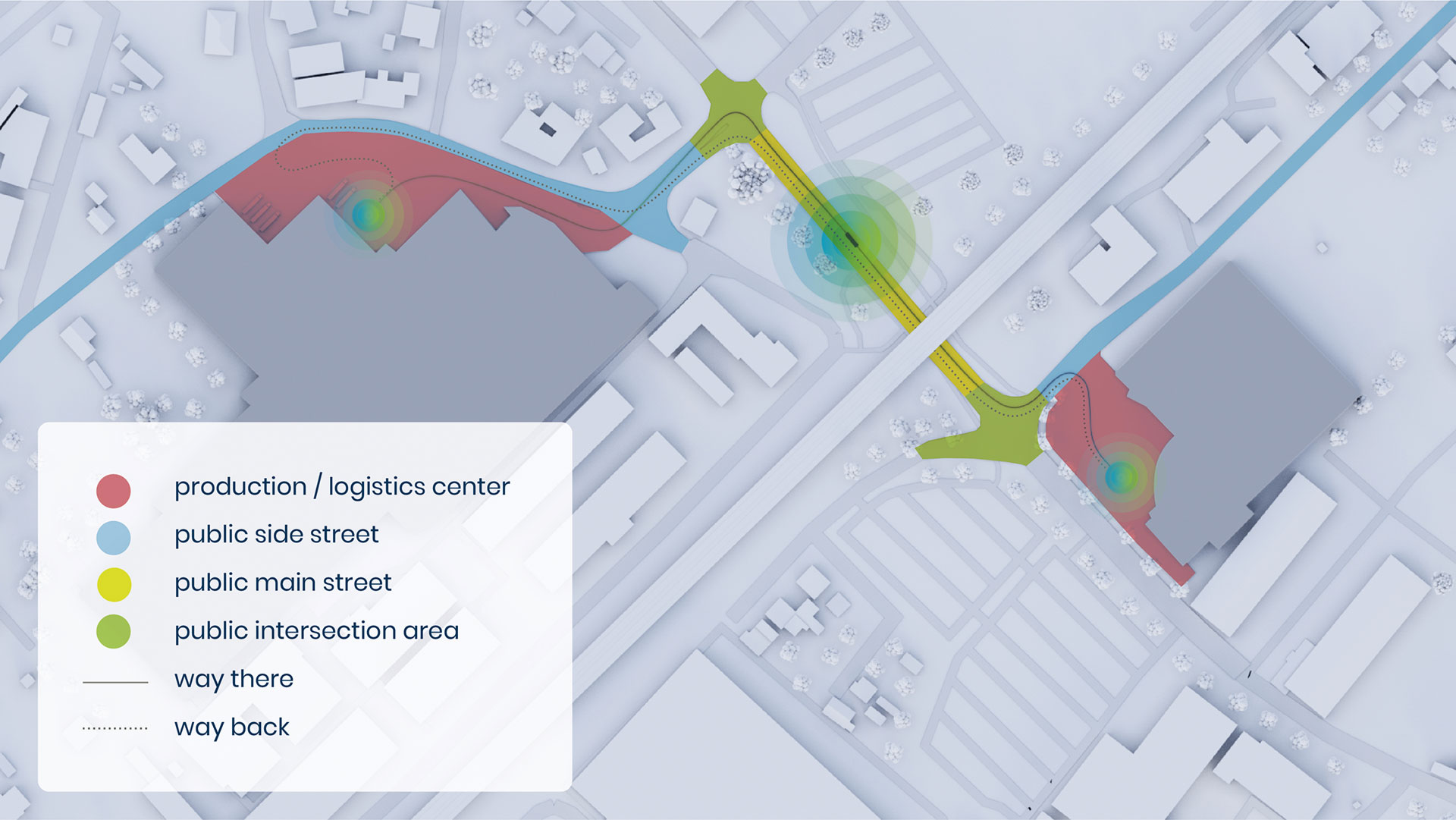Autonomous transport systems will simplify hub-to-hub transport in the future.
In a practical use case, research is being carried out in Upper Austria with the two project partners BRP Rotax and the forwarding agency SCHENKER on a public transport section with an autonomous transport vehicle for a weather-independent hub-to-hub logistics application that is suitable for everyday use. Conventional trucks currently travel exactly the same route hub-to-hub between the two companies BRP Rotax and the shipping company SCHENKER several times a day. An autonomous transport system is to be integrated by 2023 in which a fully autonomous transport shuttle (level 5) has to cover a distance of approx. 600 meters. Loading and unloading is already integrated into the project as an automated maneuver.
Project goal of the autonomous transport system (hub-to-hub)
The challenging project goal is the implementation of a real and automated transport system under difficult weather conditions and a 24h operation, seven days a week. This is the only way to ensure maximum efficiency, safety and a reduction of CO2 emissions with an autonomous transport shuttle.
The route to be realized with the autonomous transport system
For the autonomous transport system a 600m long route was defined. On this section, a driverless transport shuttle hub-to-hub should be able to operate completely autonomously by 2023.
Special challenges of autonomous
transport systems in public traffic areas
In order to be able to use an autonomous hub-to-hub transport system in public transport as well, it requires not only the latest vehicle technologies, numerous legal approval processes as well as ensuring traffic safety on the approximately 600m long route. Digitrans relies on the intelligent networking of all road users and a C-ITS controlled traffic light system. This enables the autonomous transport shuttle to anticipate these complex traffic scenarios and react in good time. This is the only way to make an autonomous transport system safe and suitable for everyday use.

The particular challenge of the autonomous transport project is the connection to the public transport network. The autonomous transport shuttle has to take into account the priority at entrances and exits, pass an unregulated intersection and be able to react to all unpredictable events of other road users.
Weather-independent, autonomous transport shuttles are in demand in Europe.
Many of the autonomous transport systems and applications tested so far have not given enough consideration to difficult weather conditions – as they often occur in our latitudes. The sensors as well as the software of the autonomous transport vehicle must, however, function reliably and safely in difficult road conditions such as: rain or snow roads, slippery roads, poor visibility and gusts of wind. That is why it is also the aim of Digitrans to set up optimal test environments here in order to enable testing under adverse road and weather conditions for such autonomous transport systems and autonomous vehicle technologies.



Complex autonomous transport systems in real traffic practice.
Together with numerous international partners, Digitrans supports and organizes the entire test conception for the realization of real-life tests in the mentioned route section and on a test track for autonomous driving . In the future, it will be possible to control different amounts of precipitation and droplet sizes on the test area with an outdoor rain system. A hub zone is also planned for testing different docking maneuvers of driverless trucks and autonomous transport vehicles. The testing of autonomous transport systems and hub-to-hub logistics applications can also be implemented in an uncomplicated and realistic manner on a closed test site.
The content of this website reflects only the author’s view. Neither the European Commission nor the INEA are responsible for any use that may be made of the information it contains.
You might also be interested in
Further Insights

AWARD H2020 – Start of test operation for automated freight transport in Gunskirchen, Upper Austria
Start of the test phase in public transport in Gunskirchen. On the approximately 600m long route between the two companies BRP-Rotax and the freight forwarder DB Schenker Austria, an automated electric truck with test approval will be tested in real operation from June 12, 2023.

EU Project AWARD H2020 – Challenges in automated freight transport
On the way to automated freight transport – Insights on the AWARD H2020 project. Digitrans project manager Hannes Watzinger provides insights into the three most important challenges during deployment.

Project RIAMO – rural communities enabled for integrated automated mobility
It involves the implementation of an efficient, automated on-demand shuttle service as part of a grant project. Accordingly, it is intended to provide residents of rural areas with better access to the higher-ranking public transport network.
